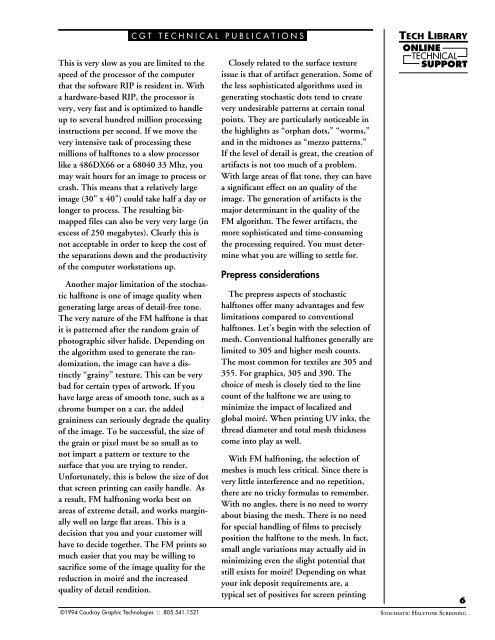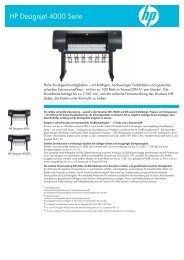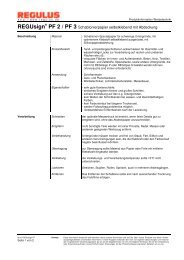STOCHASTIC HALFTONE SCREENING
STOCHASTIC HALFTONE SCREENING
STOCHASTIC HALFTONE SCREENING
You also want an ePaper? Increase the reach of your titles
YUMPU automatically turns print PDFs into web optimized ePapers that Google loves.
C G T T E C H N I C A L P U B L I C A T I O N S<br />
This is very slow as you are limited to the<br />
speed of the processor of the computer<br />
that the software RIP is resident in. With<br />
a hardware-based RIP, the processor is<br />
very, very fast and is optimized to handle<br />
up to several hundred million processing<br />
instructions per second. If we move the<br />
very intensive task of processing these<br />
millions of halftones to a slow processor<br />
like a 486DX66 or a 68040 33 Mhz, you<br />
may wait hours for an image to process or<br />
crash. This means that a relatively large<br />
image (30" x 40") could take half a day or<br />
longer to process. The resulting bitmapped<br />
files can also be very very large (in<br />
excess of 250 megabytes). Clearly this is<br />
not acceptable in order to keep the cost of<br />
the separations down and the productivity<br />
of the computer workstations up.<br />
Another major limitation of the stochastic<br />
halftone is one of image quality when<br />
generating large areas of detail-free tone.<br />
The very nature of the FM halftone is that<br />
it is patterned after the random grain of<br />
photographic silver halide. Depending on<br />
the algorithm used to generate the randomization,<br />
the image can have a distinctly<br />
“grainy” texture. This can be very<br />
bad for certain types of artwork. If you<br />
have large areas of smooth tone, such as a<br />
chrome bumper on a car, the added<br />
graininess can seriously degrade the quality<br />
of the image. To be successful, the size of<br />
the grain or pixel must be so small as to<br />
not impart a pattern or texture to the<br />
surface that you are trying to render.<br />
Unfortunately, this is below the size of dot<br />
that screen printing can easily handle. As<br />
a result, FM halftoning works best on<br />
areas of extreme detail, and works marginally<br />
well on large flat areas. This is a<br />
decision that you and your customer will<br />
have to decide together. The FM prints so<br />
much easier that you may be willing to<br />
sacrifice some of the image quality for the<br />
reduction in moiré and the increased<br />
quality of detail rendition.<br />
Closely related to the surface texture<br />
issue is that of artifact generation. Some of<br />
the less sophisticated algorithms used in<br />
generating stochastic dots tend to create<br />
very undesirable patterns at certain tonal<br />
points. They are particularly noticeable in<br />
the highlights as “orphan dots,” “worms,”<br />
and in the midtones as “mezzo patterns.”<br />
If the level of detail is great, the creation of<br />
artifacts is not too much of a problem.<br />
With large areas of flat tone, they can have<br />
a significant effect on an quality of the<br />
image. The generation of artifacts is the<br />
major determinant in the quality of the<br />
FM algorithm. The fewer artifacts, the<br />
more sophisticated and time-consuming<br />
the processing required. You must determine<br />
what you are willing to settle for.<br />
Prepress considerations<br />
The prepress aspects of stochastic<br />
halftones offer many advantages and few<br />
limitations compared to conventional<br />
halftones. Let’s begin with the selection of<br />
mesh. Conventional halftones generally are<br />
limited to 305 and higher mesh counts.<br />
The most common for textiles are 305 and<br />
355. For graphics, 305 and 390. The<br />
choice of mesh is closely tied to the line<br />
count of the halftone we are using to<br />
minimize the impact of localized and<br />
global moiré. When printing UV inks, the<br />
thread diameter and total mesh thickness<br />
come into play as well.<br />
With FM halftoning, the selection of<br />
meshes is much less critical. Since there is<br />
very little interference and no repetition,<br />
there are no tricky formulas to remember.<br />
With no angles, there is no need to worry<br />
about biasing the mesh. There is no need<br />
for special handling of films to precisely<br />
position the halftone to the mesh. In fact,<br />
small angle variations may actually aid in<br />
minimizing even the slight potential that<br />
still exists for moiré! Depending on what<br />
your ink deposit requirements are, a<br />
typical set of positives for screen printing<br />
TECH LIBRARY<br />
ONLINE<br />
TECHNICAL<br />
SUPPORT<br />
©1994 Coudray Graphic Technologies :: 805.541.1521 <strong>STOCHASTIC</strong> <strong>HALFTONE</strong> <strong>SCREENING</strong><br />
6
















